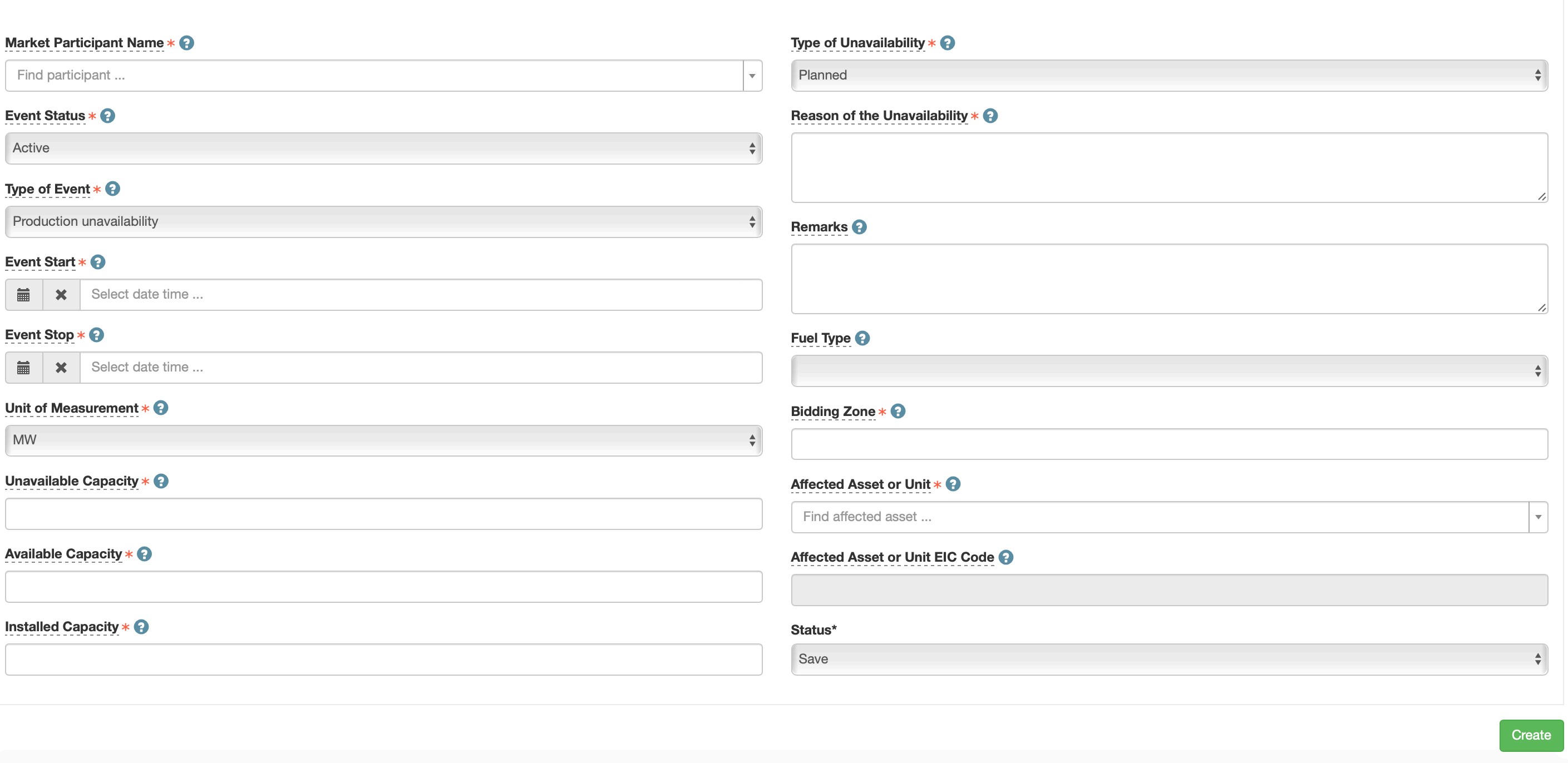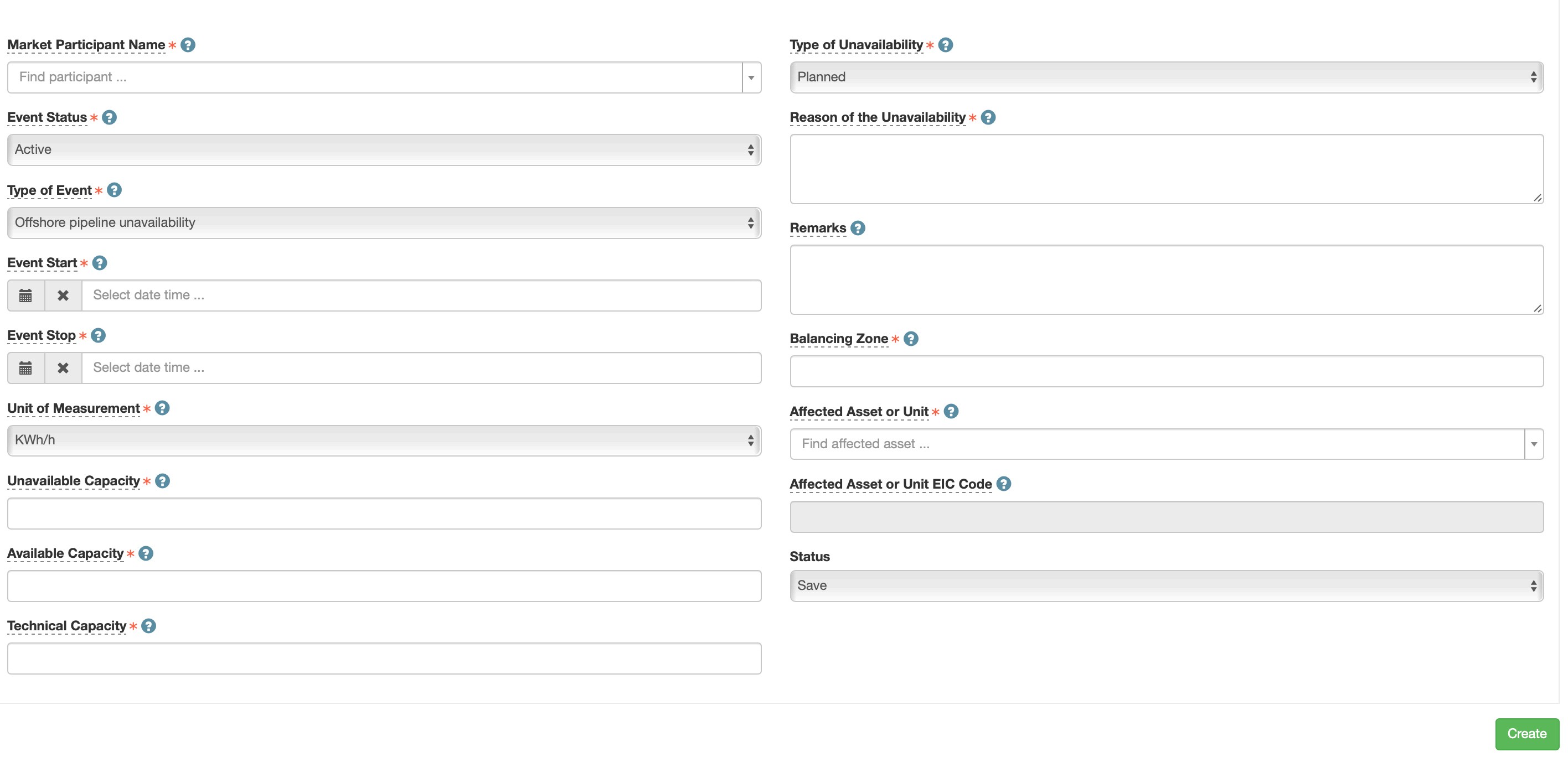Publish market information
Publishing messages and consequently reporting is only open for registered users
Before publishing the first UMM, user should maintain the master data:
— Market Participant ID;
— Asset Information.
Messages are created via a web-based form by completing a form that reproduces the fields
in the Implementation Guide.
New urgent market message
As a registered REMIT IIP user company, it will have the right to publish new messages as well as to update already published company messages.
The user must select the combination of message category, message type and type of unavailability depending on what information is disclosed. The system automatically checks that all required information has been entered, which is necessary for UMM publication. Next to each field of the publication form there are information icons with explanatory comments.
UMM history
A UMM history is a thread of messages published through the UMM system and associated with the same information or event. When publishing, information about the same event must be reported in the same UMM history. This makes it easier for the reader to keep track of new information relating to the same event and is a requirement for web-based tools to correctly send information.
Field explanation
In the section “My Messages” you can choose the type of UMM to be created and by clicking on the button “Create UMM” a message publication form will be opened. The Message Publication Form is designed with clear reference to ACER message category and type definitions.
CREATION OF ELECTRICITY UMM

CREATION OF GAS UMM

CREATION OF OTHER UMM

- Market Participant – identifies the market participant that is responsible for the public disclosure of the inside information related to the event described in the UMM. The field allows for identifying multiple market participants e.g.: a facility is associated to multiple equity holders under a joint operating agreement. In case the information is published via a third party service provider, it is the name of the market participant(s) that should be included in the field and NOT that of the service provider
- Event Status – allows the distinction between UMMs that contain the most recent information on an event and can still influence trading decisions, and UMMs that are already outdated or that were updated. The term Active refers to a UMM that contains the most recent update on an event that will occur in the future or is occurring. The term Dismissed refers to a UMM that is not valid anymore due to the fact that it was cancelled, withdrawn or updated in the meantime and the term ‘Inactive’ is used for UMMs containing the most recent update on an event that already occurred in the past, i.e., the event status from and Active UMM changes to Inactive once the event that was reported in the UMM terminates.
- Type of Event – details the subject of the unavailability. The term Production unavailability is used to report the unavailability of generation and production unit(s). The term Transmission unavailability refers to the unavailability of the transmission infrastructure. The term Consumption unavailability refers to the unavailability of electricity consumption unit(s). Other unavailability covers other types such as electric
power storage unavailability, reduction station unavailability, measurement station unavailability, etc. - Event Start – describes the expected (if future) or actual (if past) starting time and date of the relevant event. This field together with the Event stop field allows the knowledge of the timeframe of the event and the assessment of its potential impact on wholesale energy prices. The time value should be normally set at least to the minute, only if such precision is not achievable at the time of the disclosure can the time value be rounded to the nearest hour. If the exact date or time of the Event Start is not known at the time of publication, an estimate should be provided and the UMM should be updated once information exists on
the event that allows greater precision. In case of an unplanned unavailability the Event start time may fall before the Publication date/time of the UMM. Still it is important to note that, in general, no trading based on that information can occur before the UMM is published - Event Stop – describes the estimated (if future) or actual (if past) time and date at which the relevant event stops(ed). This field together with the Event start field provides the timeframe of the event and the assessment of its potential impact on wholesale energy prices. The time value should be normally set at least to the minute, only if such precision is not achievable at the time of the disclosure can the time value be rounded to the nearest hour. If the exact date or time of the Event Stop is not known at the time of publication, an estimate should be provided and the UMM should be updated once information exists on
the event that allows greater precision. In case the event is of permanent nature and the Event Stop cannot be filled (e.g.: in case of mothballing, new capacity comes online etc.), then the event should be reported using the 3rd schema type – Other market information. In that schema the field Event stop is optional. - Unit of Measurement – identifies the unit used for the reported quantity in fields Unavailable Capacity, Available Capacity, and Installed/Technical Capacity
- Unavailable Capacity – measures the capacity of the facility concerned that is affected by the event, i.e.: the capacity that will be unavailable due to the event.
- Available Capacity – measures the capacity of the facility concerned that will not be affected by the event, i.e.: the capacity that will remain available. The available capacity must be expressed in absolute terms NOT in percentages
- Installed Capacity – measures the nominal generating/transmission/consumption capacity. It is the maximum electrical active power/energy interchange the facility can produce/ transmit /consume continuously throughout a long period of operation in normal conditions, under relevant security standards.
- Type of Unavailability – indicates whether the unavailability was planned or not sorting the messages into two main types that may have different timeframes and implications on the markets. The term planned unavailability means a programmed change in capacity (for example: a maintenance, seasonal closing, etc.) and the term “unplanned unavailability” means a not programed change in capacity (for example: an outage, forced limitation). Planned events are intentional and driven by human decision while unplanned events are not intentional and usually not driven by human decision.
- Reason of Unavailability – text field to state an explanation on the cause(s) of the unavailability. This field is mandatory and reported to ACER
- Remarks – provide more detailed information on the event that allows a full understanding of its potential impact on wholesale energy prices. This field must be used when submitting the Other market information schema in order to provide an explanation on the reason(s) for the message. Other market information is usually less structured, hence the Remarks field should be used to explain the relevant circumstances of the event with regards to the possible impact on wholesale energy prices.
- Fuel Type – gives additional information on the source of energy used by the production or generation unit concerned. This field is mandatory only if production unavailability is selected in the field Type of Event. For other types of unavailability this field is not mandatory
- Bidding Zone – provides the identification of the bidding zone(s) where the affected asset or unit is located using the EIC Y coding schema on the areas for inter System Operator data interchange.
- Balancing Zone – provides the identification of the balancing zone(s) where the affected asset or unit is located using the EIC Y coding schema for the areas. The field should allow for multiple EIC codes in case several delivery points are available (e.g. gas storage connected to a number of balancing zones). In case of interconnector pipeline IN and OUT Balancing Zones shall be provided in this field.
- Affected Asset or Unit – identifies and locates the facility where the event is about to occur/is occurring/occurred using its official name. The information included in the field shall relate to a specific production/consumption asset/unit or connection. The affected facility has to be identified with the highest level of granularity i.e. if the production unit for generation of electricity is made up of an aggregation of generation units, the generation unit(s) that is (are) unavailable need(s) to be identified. In case the event cannot be associated to a single facility (e.g.: in case of general strike, floods affecting hydro generation etc.) the information should be published using the 3 rd schema type – Other market information. In case of transmission asset, IN and OUT Bidding Zones should be provided in this field
- Affected Asset or Unit EIC Code – identifies the affected asset or unit by its EIC code. It includes the EIC W, T or Z code of the facility that is unavailable. The affected asset or unit EIC code has to be identified at the most granular level i.e. if the production unit for generation of electricity is made up of an aggregation of generation units, the generation unit(s) that are unavailable needs to be identified.


